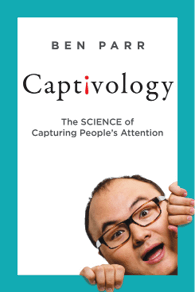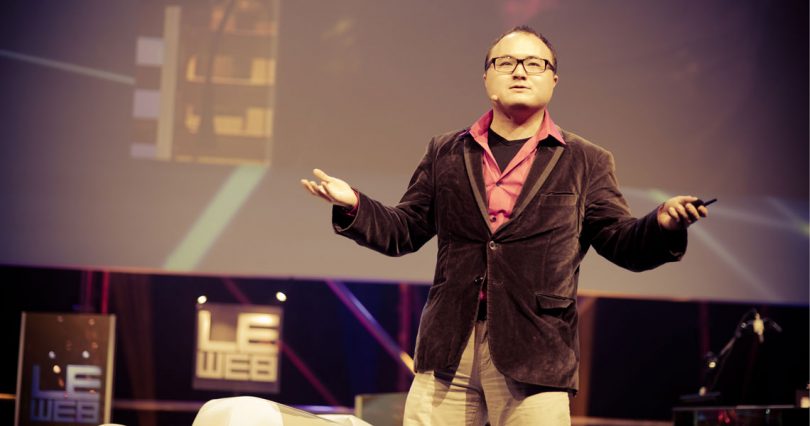Understanding the mechanics of attention and how to capture it.
 Ever feel like you’re walking around with your head in a cloud — a cloud of data? Journalist/entrepreneur Ben Parr wouldn’t be surprised to hear you say you do. In 1986, he tells us in Captivology, the average person was exposed to about 40 newspapers’ worth of information every day. Within just two decades, that onslaught had more than quadrupled, to 174 newspapers’ worth. And Parr himself, a former co-editor of Mashable and now a managing partner of DominateFund, is a prime offender: “I have no fewer than 15 windows and 25 tabs open on two monitors at any time,” he confesses. “I track tech, entertainment, media and science news across six Twitter accounts in a desktop app called TweetDeck.”
Ever feel like you’re walking around with your head in a cloud — a cloud of data? Journalist/entrepreneur Ben Parr wouldn’t be surprised to hear you say you do. In 1986, he tells us in Captivology, the average person was exposed to about 40 newspapers’ worth of information every day. Within just two decades, that onslaught had more than quadrupled, to 174 newspapers’ worth. And Parr himself, a former co-editor of Mashable and now a managing partner of DominateFund, is a prime offender: “I have no fewer than 15 windows and 25 tabs open on two monitors at any time,” he confesses. “I track tech, entertainment, media and science news across six Twitter accounts in a desktop app called TweetDeck.”
Every time Parr discovers another aspect of The New Distractability — such as the fact that it can take the average multitasker an astonishing 23 minutes to get back on track — he redoubles his efforts to plumb the mechanics of attention (both our own and others’) and how to galvanize it. The results are not always captivating, in all honesty, but Captivology always moves quickly, and the book does a good job of melding social science with Business 101.
If you want to capture attention for your ideas, your work or your product, you will not only have to compete against countless people and companies who are vying for the same attention you are, but you’ll also need to fight against the very unproductive habits that we have all developed to manage our attention in the midst of overwhelming stimuli.
Myth Buster
In distinguishing short attention from long attention — the first is triggered by novelty and extrinsic rewards, the second by familiarity, interaction and emotional rewards — Parr refreshingly explodes the myth of the “overnight sensation.” No, Beyoncé was not an instant success; she had to put in “years of hard work and audience building … to get to the point where millions are willing to pay attention to her by default.” Pinterest caught on right away, correct? Not so much; it had been around for three years before finally gaining traction in 2011. Pop star Psy, another long-term attention-builder, had seen his songs top the charts in his native South Korea for almost 10 years before “Gangnam Style” dancing swept the planet. As for Angry Birds, well … would you believe it was the 52nd computer game released by software company Rovio?
As Parr walks us through the various mechanisms (he calls them triggers) that direct our attention to a person, a product, a brand or an idea, he occasionally risks straying into “Captain Obvious” terrain. But he always manages to have fun with his material. Sensory cues — for example, colors, shapes, temperatures — are essential to grabbing the attention of an audience composed of creatures with scarce working memory, namely humans. So if you want to make your friends (or clients) feel energized, expose them to more red and orange. If you want people to pay attention to your presentation, shun the traditional powder-blue collared shirt (Parr is partial to pinks and purples himself). And because researchers have shown that “simply holding a hot object can generate positive feelings about others,” think about handing a potential buyer a hot cup of coffee when you go on a sales call.
If you read a lot of business books, Parr’s “attention” conceit can start to feel like a rickety scaffolding on which to display the latest findings from the field of social psychology. But his chapter on the “Disruption Trigger,” may force you to streamline some of your own transactional processes.
Disruption is a great way to draw notice to your product or idea, Parr explains, because when you violate someone’s expectations, you force them to pay attention until they can figure out whether the disruption is a pleasant surprise or a possible threat. In the “pleasant surprise” category, Parr details Patagonia’s Black Friday sales campaign of 2011, which urged its customers, “DON’T BUY THIS JACKET.” Instead, the outdoor-clothing company encouraged consumers to repair their gear before buying new replacements. Result? “Patagonia’s sales skyrocketed by 40 percent the two years after the campaign.”
Keep It Simple
I’m pretty sure Parr would not counsel REALTORS® to attempt a “DON’T BUY THIS HOUSE” marketing campaign. But whatever sort of attention-grabbing strategy you come up with yourself, it’s essential to sidestep the “complexity trap”: Keep the unexpected idea — and therefore its attendant message — as simple as you possibly can.
Apparently this all has something to do with “cognitive load.” Think of Steve Jobs ruthlessly cutting unnecessary features from every product that Apple put on the market under his stewardship and you will start to get the idea. “Remove everything that isn’t vital to the integrity of your message, idea or product,” the author insists, starting with that most hideous distraction of all, bullet points: They are “the antithesis of simplicity and rarely add value to a presentation,” he explains, because they force your audience “to both read what is on the screen and listen to what you have to say at the same time.” Instead, consider using photographs or other images to convey your key points, and don’t “bury the lede” — that is, tell your audience up top what they will learn from your talk.
In a world where the average person checks his or her smartphone 110 times a day — and where audience attention has become so fickle that 4 out of 5 YouTube viewers bounce away from a video if it pauses to buffer even once — Ben Parr’s Captivology merits some close consideration.
[module-226]







